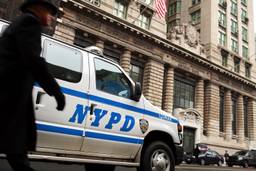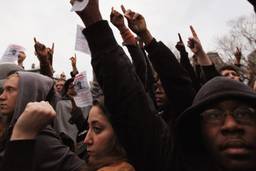In speaking with Occupy protesters and their allies over the past (nearly) four months, I’ve come to learn that the biggest deterrent to hitting the streets and demonstrating against Wall Street’s greed is police retaliation in the form of physical abuse and arbitrary detainment.
Police can, and do, detain individuals for any number of reasons, some completely fabricated, a statement received as old news by minorities and seasoned protesters, and which became a reality for journalists covering the Occupy beat this fall.
The NYPD has been routinely criticized for violating the First Amendment rights of journalists (independent and mainstream alike) in addition to impeding on the rights of protesters, sometimes sweeping up entirely peaceful demonstrators under the blanket charge of “resisting arrest.” Oftentimes, protesters who lose days of their lives as they’re held in cells, are never charged with anything.
Most recently, prosecutors dropped charges against 21 people picked up in the first mass arrest of Occupy Wall Street demonstrators. The charges were dropped because prosecutors admitted they could not prove beyond a reasonable doubt that the conduct in the cases was illegal.
Fifty other cases are on their way to trial. The arrests occurred on Sept. 24 and only now have the charges against nearly two dozen individuals been dropped, to give the reader an idea of how slow the “justice” process actually is.
The glacial speed of the courts is why many protesters don’t bother demanding a trial in front of their peers. Many activists have jobs and other obligations they need to return to, and don’t have time to struggle with an unfeeling bureaucratic system in order to demand accountability.
I recently witnessed one of the most glaring examples of trumped up charges at a #J3 Occupy protest. OWS activist Lauren Digioia was snatched off the floor of Grand Central Station by police for the crime of using the People’s Mic, that is speaking loudly in a public space, which is still a legal act the last time I checked.
Later, the NYPD attempted to charge Digioia with resisting arrest, a claim that can be debunked simply by viewing the video of her arrest. Digioia is a slight woman, who was easily carried down the stairs by the six, or so, arresting officers.
“I was locked up for 26 hours,” Digioia told independent journalist John Knefel in a report for Citizen Radio. “It sucks to get locked up for that long, but I’m really glad I did it. It sets the tone for what NDAA has the capability of doing to us as citizens. It’s another example of how our First Amendment rights are not protected at all.”
Knefel reports that Digioia was held for those 26 hours in a holding cell (one of two) in Grand Central Station’s basement.
“When I went down to ask where she was, and I asked one of the officers on duty if she was being held there. He told me she wasn’t, which considering the fact that the protest earlier that day was about a bill that allows for American citizens to get disappeared and held indefinitely, is very troubling,” said Knefel.
Knefel is correct. It’s deeply troubling that a U.S. citizen was disappeared from a public space for the “crime” of speaking, then held in an off-site police cell, and her whereabouts were not disclosed to a journalist making inquiries about her location.
As the NYPD busily breach the rights of citizens, the New York Civil Liberties Union and the National Lawyers Guild filed a complaint Monday, saying the barricades surrounding Zuccotti Park violate zoning laws by restricting public access.
The complaint says the metal barricades that have surrounded Manhattan’s Zuccotti Park since Nov. 15 interfere with the public’s use of it. Zuccotti Park is a publicly owned private plaza and is required to be open 24 hours a day, barring a safety issue.
City zoning law states the layout and design of such parks must promote public use and “free and easy pedestrian circulation.”
Truly, we are living in Orwellian times when things like arbitrary arrests, “freeze zones,” the barricading of public space, and intimidation of the press are all tools used by police to “protect” citizens.

I hope you found this article important. Before you leave, I want to ask you to consider supporting our work with a donation. In These Times needs readers like you to help sustain our mission. We don’t depend on—or want—corporate advertising or deep-pocketed billionaires to fund our journalism. We’re supported by you, the reader, so we can focus on covering the issues that matter most to the progressive movement without fear or compromise.
Our work isn’t hidden behind a paywall because of people like you who support our journalism. We want to keep it that way. If you value the work we do and the movements we cover, please consider donating to In These Times.



